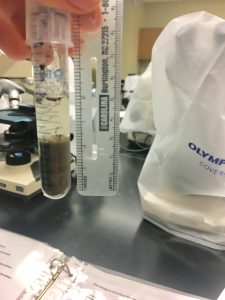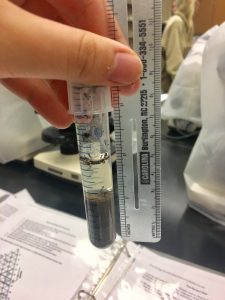November
24
Lab experiment #12 (11/09/17)
Purpose: The purpose of this experiment was to find how much sand, clay, and silt was in our soil samples. After discovering the amount of sand, clay, and silt in our soil, we were able to determine what type of soil we collected.
Procedure:
- Obtain falcon tube that was created in the previous lab. You should be able to see different layers of silt, clay, and sand.
- Using a ruler, measure each layer to the nearest millimeter. Record information in your lab notebook.
- Measure the height of the soil.
- Divide the amount of silt by the height of the sample.
- Divide the amount of sand by the height of the sample.
- Divide the amount of clay by the height of the sample.
- Determine soil type using this chart:

- After determining your soil type, look for ciliates in your non-flooded plate.
Results:
Clay: (2mm/26mm) x 100=7.69%
Silt: (11mm/26mm) x 100= 42.31%
Sand: (13mm/26mm) x 100= 50%
Soil type: Loam
Conclusion: Overall, we were able to calculate the amount of clay, silt, and sand. By doing this we were able to determine the type of soil we collected at the beginning of the year. By doing this, it helped us realize how much of a variety of soil that we have on campus, and it could potentially tell us which soil ciliates are more commonly found.



